Take Five with Chef Justin Simoneaux of the Boxing Room, Who Proves You Can Take the Boy Out of Louisiania, But Not Louisiana Out of the Boy
Executive Chef Justin Simoneaux wears his heart on his sleeves.
His tattoo sleeves to be exact.
Take a close look at the artwork on this 27-year-old’s arms and you’ll understand what’s near and dear to this chef of San Francisco’s Boxing Room.
On the right arm of this Southern Louisiana native is a tiny front-page of the New Orleans Times-Picayune. That’s accompanied by all the makings for a crawfish boil (potatoes, crawfish and crab) and the Cajun ”holy trinity” of onion, bell peppers and celery.
On his left arm is the cityscape of New Orleans, the bayou and gravestones of dearly departed ones.
At the Boxing Room, part of the Absinthe Group of restaurants in San Francisco, Simoneaux cooks up the food of his beloved Louisiana: gumbo, deep-fried alligator, Southern fried chicken, and duck and sausage jambalaya. Before that, he honed his skills in Mediterranean cuisine at Coco500 in San Francisco, and the Moss Room at the California Academy of Sciences in San Francisco.
Last week, I had a chance to sit down with him to talk about how his roots and his upbringing (his mother was only 18 when she gave birth to him) have influenced his career, which started when he took a job as a dishwasher at age 15 at a restaurant near his high school.
Q: Are you cooking the food of your childhood here?
A: It’s the food I grew up eating, but I’m using my training to better the recipes. Don’t tell my Mom and Grandma I said that.
Q: You learned how to cook from them?
A: In Louisiana, everything centers around food. My Mom and Granny made gumbo and stews. My grandfather boiled crawfish and did a lot of grilling. I’d always be like, ‘Ooh, what is that smell?’ I was intrigued from an early age.
Q: Did you always know you wanted to be a chef?
A: When I worked as a dishwasher, then as a line cook, I just fell in love with the adrenaline and energy. I came out here for culinary school (California Culinary Academy) with the intention of going back to Louisiana afterward. But I’ve been here seven years now and love it. I feel like I have two homes now.
Q: When you go back to Louisiana to visit, is there something you just make a beeline for that you’ve just got to eat first?
A: I get a lot of my food fixes here now, so I don’t have that immediate feeling any more of getting off the plane in search of gumbo or crawfish. Plus, I make it the way I like it here, so it’s hard to beat. (laughs)
Probably what I want most when I go home now is my Mom’s butter beans braised with chicken. Or her shrimp-okra gumbo or fried pork chops.
Q: So who’s the better cook now — you or Mom?
A: She is. Cooking pays my bills, but she’s a far better cook than I am. I wouldn’t be the cook I am today without the life lessons she taught me. She taught me to appreciate the little things. And that time, patience and love will make good food and a good living. They go hand in hand.
Q: Does your Mom come out here to visit often?
A: Once a year. And she does eat in my restaurant. She’s my biggest fan and critic. She has opinions on all the dishes, mostly positive ones.
We do disagree sometimes. That’s the way of Louisiana cooking — their way is the best way, the only way.
Q: You were in San Francisco when Hurricane Katrina hit Louisiana?
A: I moved here just before that. I’ve since met people who moved here after the storm and they are some of my best friends now.
I saw people fight so hard after all that devastation. It just goes to show you how strong the culture is and that not even Mother Nature can take that away.
Q: How do you feel about Chef Charles Phan having plans to open a Cajun restaurant in San Francisco? Will the two of you be duking it out for the title of best gumbo?
A: The more, the merrier. How many Italian restaurants are there in San Francisco, right? I feel more of the pressure, though, because I’m the native.
To understand Louisiana cooking completely, you have to dive into it. You just can’t read a recipe. It’s hard to pick up a gumbo recipe and just make a great gumbo. You have to know how to take a roux dark to just right before it burns.
Q: You grew up hunting and fishing in Louisiana? What did you catch?
A: I’d fish every week with my uncles or grandfather. If it was salt water, it was redfish and flounder; if it was fresh water, it was perch and catfish. Sometimes we’d go crabbing, too.
Q: How old were you when you hunted for the first time? Was it scary?
A: I was 6 or 7. It’s part of life there, so there’s nothing scary about it. Your backyard is basically the bayou or the woods. We’d hunt for rabbits, ducks and squirrels.
Q: What does squirrel taste like? Don’t tell me like chicken.
A: It’s mild. There’s a little gaminess to it. It’s a little like rabbit, but with darker meat.
Q: When you’re not cooking Cajun-Creole food, what do you like to eat?
A: My girlfriend is Japanese (and a line cook at Spruce in San Francisco), so we go to a lot of izakayas and shabu houses. (laugh) We just made a pact to venture beyond Japanese food. I’m also a sucker for good barbecue and a burger.
Q: Do you two cook at home?
A: No that often. When we do, we keep it simple like roast chicken and mashed potatoes. We try not to get too fancy or it’s just a bigger mess to clean up. Minimal clean-up is our goal.
Q: What’s the most unusual item in your fridge or pantry?
A: Stinky tofu. Just the smell alone takes the cake. My girlfriend cooks with it. It’s all right; it’s not my favorite.
Q: What is your favorite ingredient?
A: Salt. Can I say that? It’s the most necessary ingredient.
Q: What’s your least favorite ingredient?
A: (He pauses for awhile in thought.) Hmm, I think everything has its purpose. Maybe sea squirts might be my least favorite? I think they’re related to sea cucumbers.
Q: What’s the last book you looked at?
A: Paul Bertolli’s “Cooking by Hand” (Clarkson Potter). We got a whole pig in yesterday and I was looking for a recipe for cotechino, a sausage that’s made with a lot of pig skin.
Q: What’s one thing people would be surprised to know about you?
A: I try to keep those things a secret! (laughs)
I recently picked up golf. Not that that’s unusual, but some people seem really surprised: ‘You play golf?!’
Q: Are you good at it?
A: I guess I’m good for someone who has played for three months.
More: My Q&A with Executive Pastry Chef Bill Corbett of the Absinthe Group

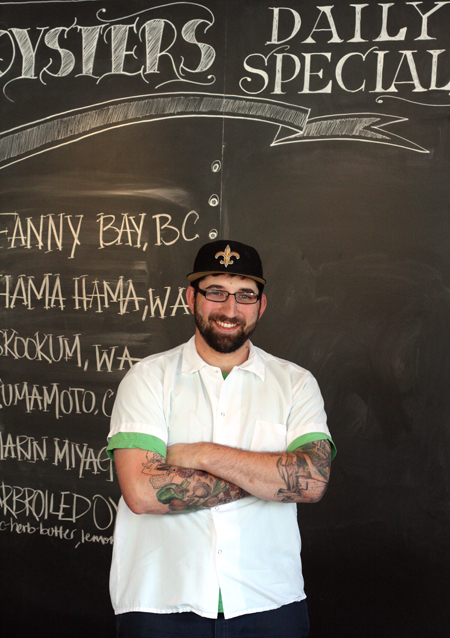
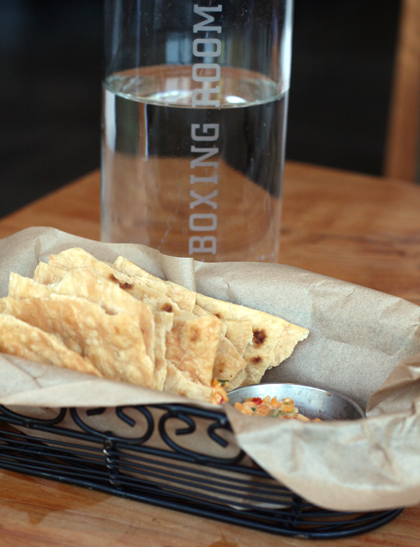
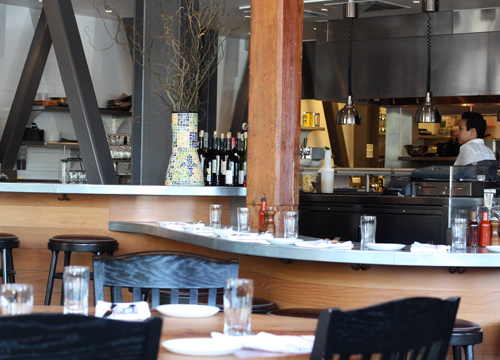
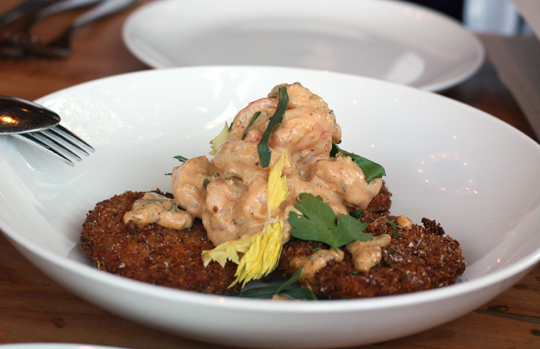

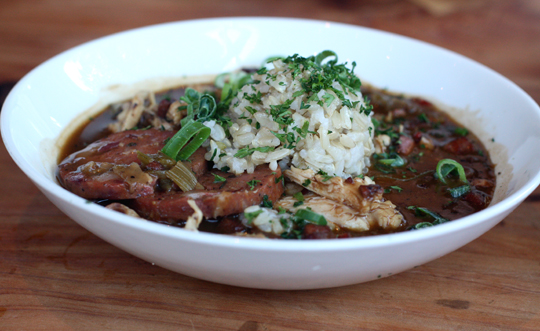
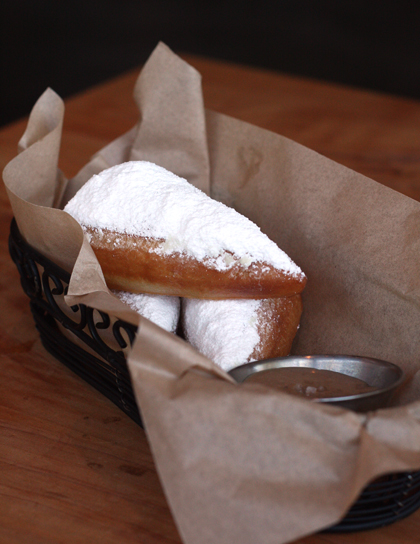
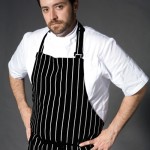
Thanks for the lovely interview! I’d love to visit Louisiana…
The fried green tomatoes and shrimp remoulade dish looks amazing.
Cheers,
Rosa
Fun interview. He had such a wonderful food background growing up – and it shows in his cooking.
Oh man, I want Chef Simoneaux and his girlfriend to open a Louisiana-Japanese inspired restaurant!! (You can thank me later for the idea.) … Love the Boxing Room. Great party vibe and good food that’s a touch above comfort eating.
Really great interview – I thoroughly enjoyed this. Asking what book someone last looked at is a wonderful question. And Cooking by Hand is such a great book. This was totally fun – thanks.
Cajun food is one type that we don’t get enough of here but I’ve loved everything that I’ve tried of it! What a fascinating guy!
Love the interview, Justin sounds like such a nice and humble person, and that food looks amazing!
What a fun interview to read. Great questions to get to know him more. It’s always interesting to hear how cooks become professional chef.
It’s always interesting to hear how cooks become professional chef.
Thank you for the awesome interview. Of course it brought me to tears. I can never express how proud I am that he calls me mom. I love him dearly. He has grown to be a great young man. Justin started in the kitchen at home when he was 10. Living along bayou lafourche, I never knew what I would find on the stove. It didn’t surprise me that he chose a culinary career.
Really fun interview! So cool that his mother commented, too! Thanks, Carolyn!